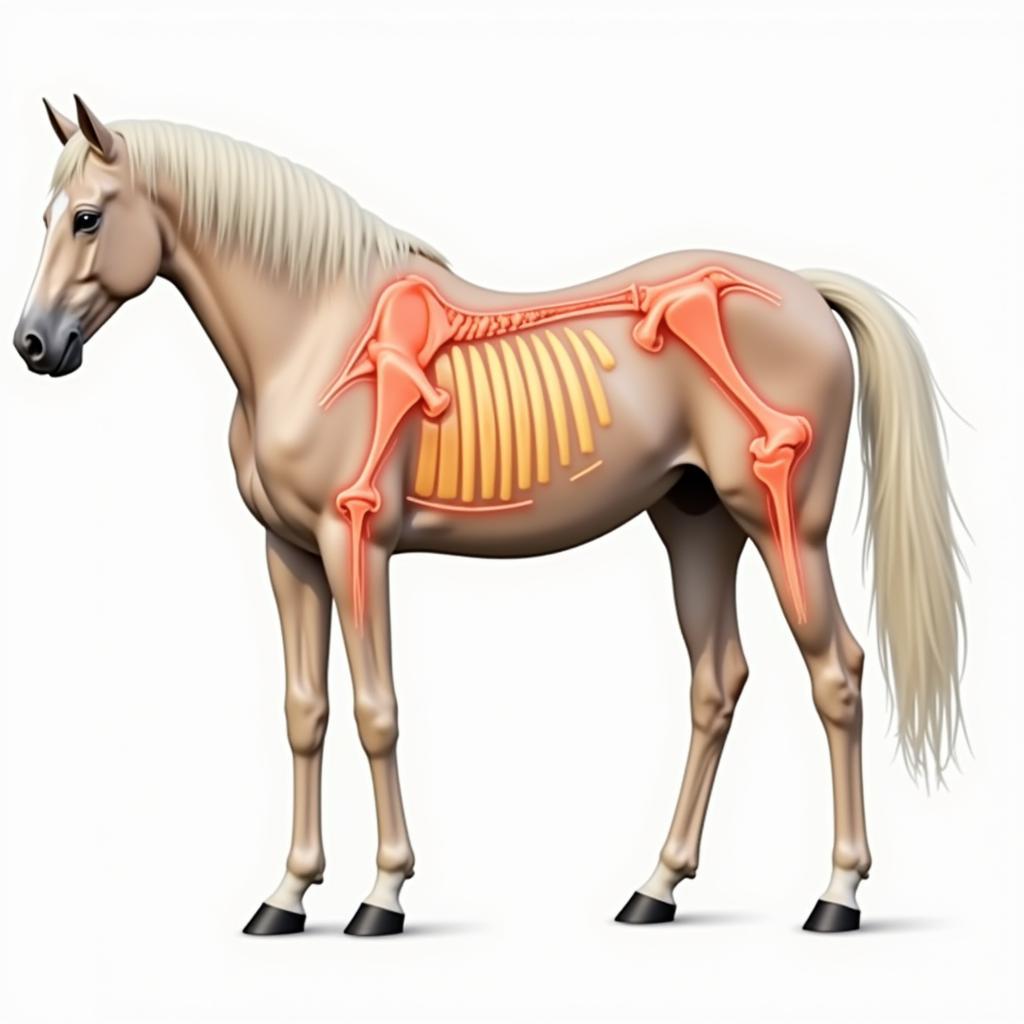The Horse Sacrum, a crucial part of the equine skeletal system, plays a vital role in connecting the spine to the pelvis. Understanding its anatomy and function is key to recognizing potential issues and ensuring your horse’s overall well-being. This article dives deep into the horse sacrum, exploring its structure, common problems, and how they can impact your horse’s performance.
The Anatomy of the Horse Sacrum
The sacrum is a single bone formed by the fusion of five sacral vertebrae. It’s located between the lumbar vertebrae of the spine and the first coccygeal vertebra, essentially bridging the back and the pelvis. This triangular bone is a critical component of the horse’s hindquarters, contributing significantly to stability and power. The sacrum’s unique structure, with its strong ligaments and articulation with the ilium (part of the pelvis), allows for efficient transfer of force from the hind limbs to the rest of the body. This is particularly important for activities like jumping, galloping, and even just carrying a rider.
 Horse Sacrum Anatomy Diagram
Horse Sacrum Anatomy Diagram
This complex structure is subject to various stresses and strains, which can lead to a range of issues.
Common Problems Affecting the Horse Sacrum
Several issues can arise with the horse sacrum, ranging from minor discomfort to significant lameness. Some of the most common problems include:
- Sacroiliac (SI) Joint Dysfunction: This often occurs when the sacroiliac joint, where the sacrum meets the ilium, becomes inflamed or strained. Symptoms can include stiffness, difficulty with transitions, and hind limb lameness.
- Fractures: While less common than SI joint issues, fractures of the sacrum can occur due to trauma, such as a fall or kick. These are serious injuries that require veterinary attention.
- Arthritis: Degenerative joint disease can affect the sacroiliac joint, leading to pain and stiffness.
 Horse Sacrum and SI Joint Dysfunction
Horse Sacrum and SI Joint Dysfunction
Recognizing the signs of these issues early is crucial for effective management and treatment.
What are the Signs of Sacrum Problems in Horses?
Symptoms can vary depending on the specific issue but can include:
- Changes in gait: A shortened stride, reluctance to move forward, or dragging of the hind limbs are common indicators.
- Behavioral changes: Horses may exhibit signs of discomfort, such as restlessness, irritability, or difficulty standing.
- Sensitivity to touch: Palpation of the area around the sacrum may elicit a pain response.
Diagnosis and Treatment of Horse Sacrum Issues
Diagnosing sacrum problems typically involves a thorough physical examination by a veterinarian, often supplemented by imaging techniques such as X-rays or ultrasound. Treatment options vary depending on the specific diagnosis and severity of the issue. Conservative management may include rest, horse si joint stretches, anti-inflammatory medications, and physical therapy. In more severe cases, surgery may be necessary.
Expert Insights
Dr. Emily Carter, DVM, a renowned equine veterinarian specializing in sports medicine, emphasizes the importance of early diagnosis. “Early detection and intervention are key to managing sacrum problems effectively. The sooner we can identify and address the issue, the better the chances of a full recovery.”
She further adds, “Proper conditioning, balanced nutrition, and appropriate riding techniques can also help prevent sacrum issues in horses.”
Conclusion
The horse sacrum, a complex and vital part of the equine anatomy, plays a critical role in movement and stability. Understanding its function and potential problems can help horse owners recognize issues early and seek appropriate veterinary care. Early intervention and proper management are crucial for maintaining the horse’s health, comfort, and performance. Remember, a healthy sacrum is essential for a happy and active horse.
FAQ
- What is the horse sacrum?
- What are the common problems associated with the horse sacrum?
- What are the signs of sacrum problems in horses?
- How are horse sacrum problems diagnosed?
- What are the treatment options for horse sacrum problems?
- How can I prevent sacrum problems in my horse?
- What is the role of the sacrum in horse movement?
Need help? Contact us at Phone: 0772127271, Email: [email protected] Or visit us at: QGM2+WX2, Vị Trung, Vị Thuỷ, Hậu Giang, Việt Nam. We have a 24/7 customer support team.